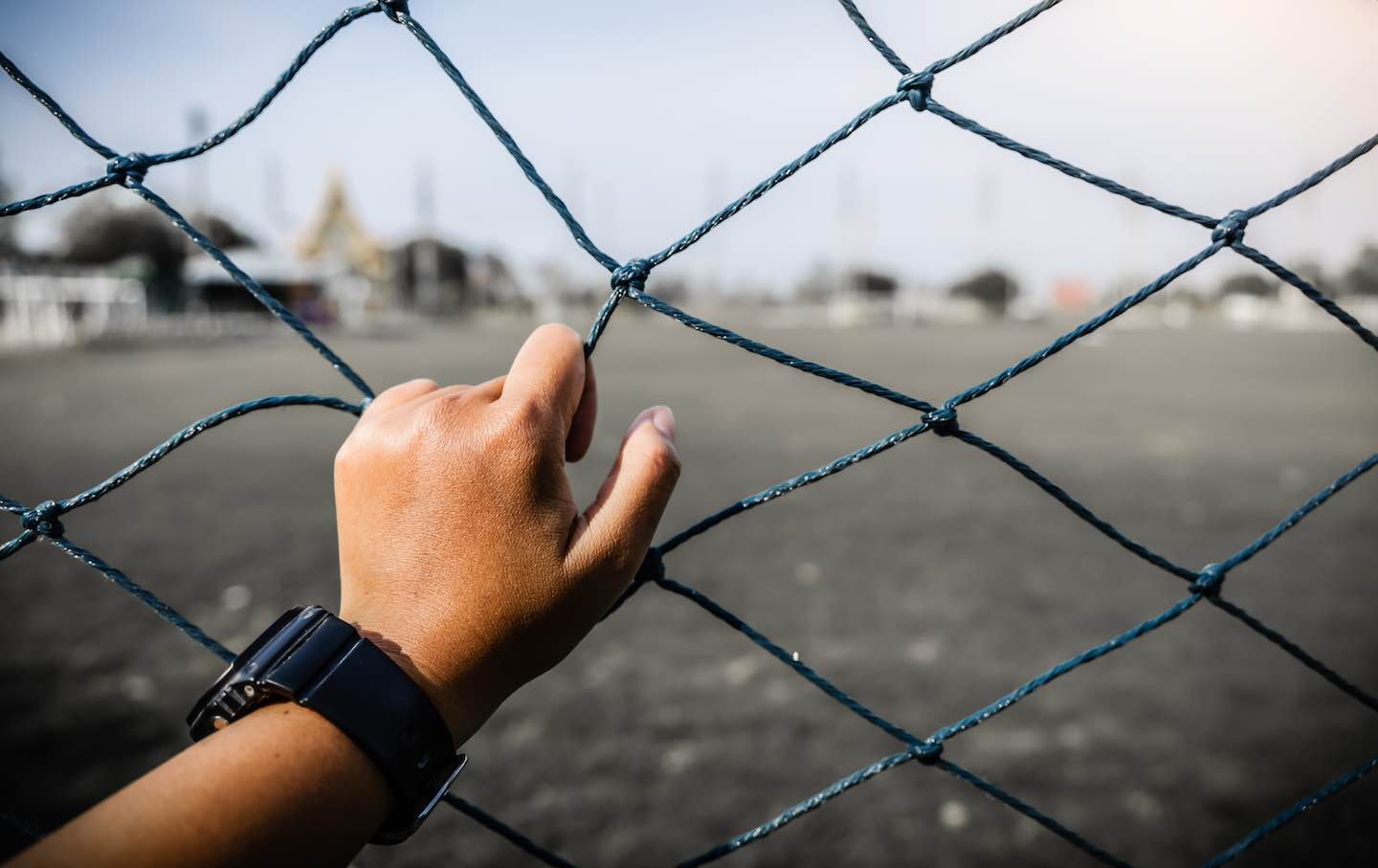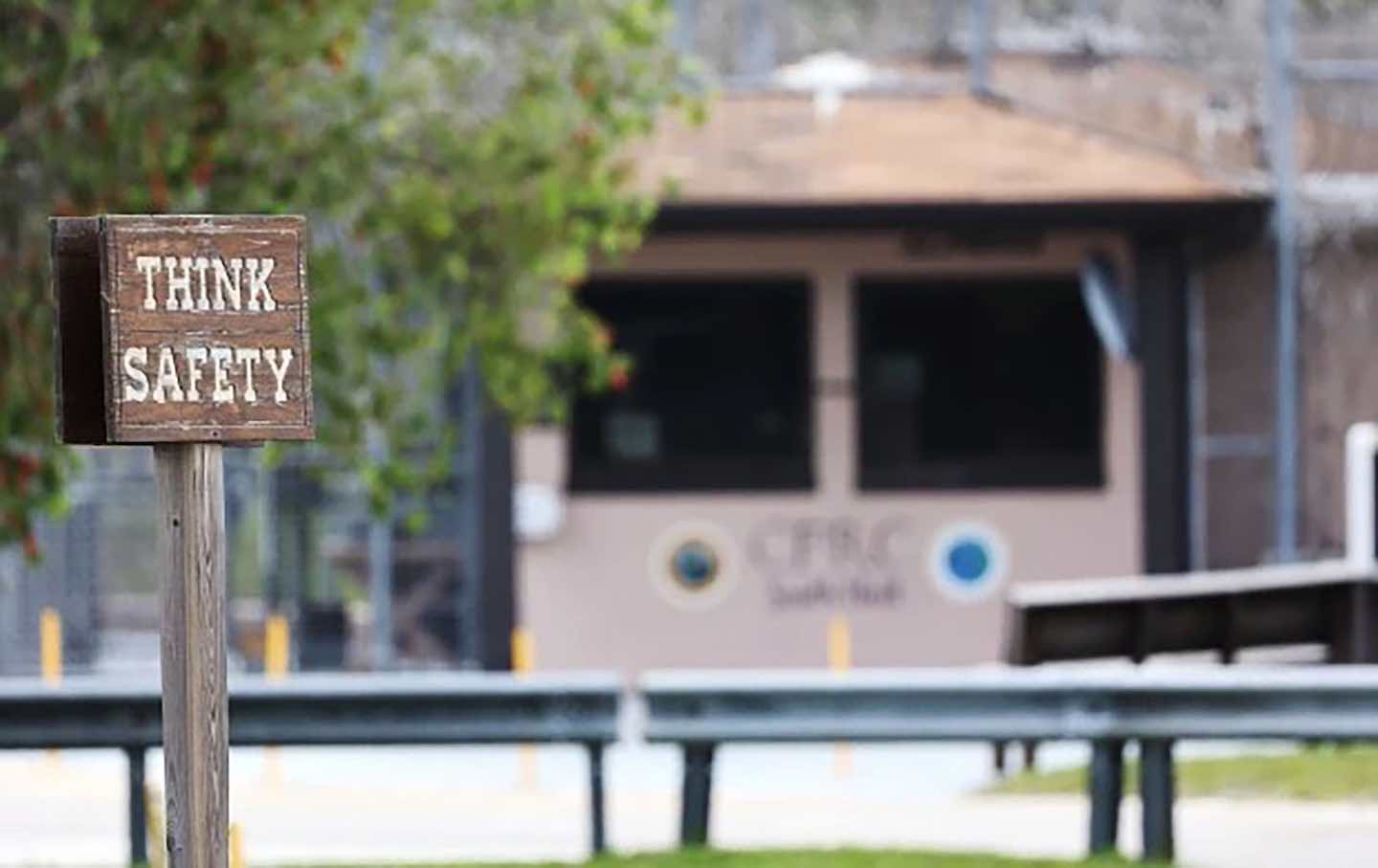The Carceral System Enters Its Smartwatch Era
Wrist monitors like the BI VeriWatch dominated at a recent industry conference. But some 20 miles away, incarcerated men had other ideas about what the future should look like.

Inside a clear box, a rotating forearm displays a hunky silver plastic watch billed as “next-level intelligence” for the corrections industry.
Smartwatch is a first in corrections, explained Jon Logan, the CEO of Smart Communications. The incarcerated person wearing the watch can use it for phone calls and text messages—each message costing them 50 cents.
Then, officials can keep track of their health biometrics, covertly listen to incarcerated people without them knowing, or track locations and re-create who was on scene if, for example, there’s a riot.
“It just gives [correctional officers] next-level kind of control and intelligence into what’s going on inside the prisons,” Logan said.
He was one of several salespeople who participated in January’s American Correctional Association’s (ACA) annual Winter Conference, a five-day convening in Orlando, to “teach, communicate and map out the future of [the] profession,” promises their 178-page program book.
A different booth showcased a system to detect drones dropping contraband into prison. There was also the “eCig4inmate,” a vape available in regular, menthol, or mixed berry flavors; and nearby, the “Drugloo,” where contraband is defecated into a covert, self-contained toilet, washed, and shot into an evidence box smelling like lavender.
The oldest and largest corrections group’s conference also offered tours to nearby prisons and jails. Or attendees, from Federal Bureau of Prisons policy wonks to prison wardens, could drop into one of dozens of workshops offered: learning hiring techniques at “How to Hire an Officer in Ten Days” or “learn why the minds of some individuals might be wired for crime” at “Beyond Good and Evil: Inside the Mind of a Psychopath.” A colonel told me the workshop was insightful for “dealing with an inmate population—or to know personally.”
It’s an opportune time for prison behemoths to plan for the future of the industry. Stocks of two key players in private prisons, CoreCivic and Geo Group, soared after President Donald Trump won reelection in November. Both were sponsors of the conference. Not to mention that Pam Bondi, Trump’s attorney general, lobbied for Geo Group. And Trump wasted no time after his inauguration to reverse a Biden administration policy that had directed the Justice Department not to renew contracts with private prisons.
The private prison population is only a small share of those in the US carceral system—about 150,000 people as of 2024. That’s just 8 percent of the over 1.9 million people incarcerated across prison and jail systems in the United States, according to the Prison Policy Project. And after reductions during the height of the pandemic, 2022 marked the first year in more than a decade when the prison population rose again, by 2 percent, keeping the US at the largest carceral population in the world
On a November earnings call, a GEO Group official said they “stand ready to provide additional services and resources to help ICE meet its future needs” as Trump takes an aggressive approach to immigration, including increasing the number of people held in detention facilities and the number of people monitored who are not detained.
“We believe we have the necessary technology and staffing resources to scale up the current utilization of the [Intensive Supervision Appearance Program, or ISAP] contract by several hundreds of thousands and upward to several millions of participants,” George Zoley, executive chairman and founder of GEO Group said on the call.
US Immigration and Customs Enforcement (ICE) contracts account for 43 percent of Geo Group’s revenues and 30 percent of CoreCivic’s, according to recent annual reports from each company. That ICE revenue pays for detention facilities, transportation, and monitoring. As of early January, about 188,000 people were subjected to the ICE’s “Alternative to Detention” program, meaning the Intensive Supervision Appearance Program. The program monitors non-detained noncitizens through technology like ankle monitors. In 2020, BI Incorporated, a subsidiary of GEO Group, won an up to $2.2 billion five-year contract to administer the program.
Regarding immigration expansion, GEO Group in a statement said in part that they “are currently investing $70 million toward increased housing, transportation and monitoring capabilities and services to meet the anticipated requirements of the federal government’s immigration law enforcement priorities” and that they’re “proud of [their] record of working closely with federal, state, and local government agencies to ensure that all persons entrusted to our care are treated in a safe, secure and humane manner.”
Laura Rivera, senior staff attorney with Just Futures Law, who provides legal support on immigrant rights and tech surveillance, has seen the evolution of ICE’s surveillance under ISAP: from in-person check-ins and phone calls to ankle monitors to SmarkLINK, an app that uses “check-ins using biometric facial comparison and liveness detection technologies.”
In 2023, the agency announced that it would begin testing wrist-worn GPS technology. Rivera has not worked with people who have used this technology, but she said she has “every expectation and concern that we can expect an expansion of these modes of surveillance under the current administration.”
ICE did not respond to a request for comment.
Inside the ACA’s exhibitor hall, this nascent surveillance seemed to be on the brink of an industry breakthrough as more companies enter the watch market.
While others in the ACA exhibit hall made a point to catch the eyes of potential clients with their wares—GEO Group needed no introduction. Their booth was a small lounge area, white chairs and a bromeliad, surrounded by signs touting their “continuum of care,” “rehabilitation and reintegration.”
Two Geo Group employees showed me their nearly identical smartwatches; one is an Apple Watch, the other the BI VeriWatch, a monitoring device that, to their point, blends in like any other smartwatch. It’s from BI Incorporated and came on to the market in 2023. It’s part of the electronic monitoring arsenal that brought in about $425 million for GEO Group in 2023.
They would not speak with me on the record, but did hand me an informational sheet: “GPS technology clients can wear with confidence.” It is “equipped with biometric facial comparison technology, liveness detection, an on-device camera and an optical proximity sensor. VeriWatch is the first community supervision location tracker to biometrically authenticate the identity of the wearer by comparing a new photo against photos established at enrollment,” it continues.
Down the exhibit hall, David Couch, a business development specialist with 4Sight Labs, said the watches are trending because there’s “comfort and durability” for the person detained. 4SightLabs’s watch, OverWatch, has monitored over 8,000 people. They’re placed on someone from the point of arrest through transport and into detention, monitoring location, heart rate, skin temperature, blood oxygen, and motion.
“We put something on the leg…you have a lot more pounds per pressure on your leg to knock something off or break something off than you do on your wrist,” Couch said.
While the watch is billed as less stigmatizing than the ankle monitor, it further normalizes the extension of the carceral state, Rivera said. She hasn’t had clients subjected to the watch but has worked with those on similar technology like SmartLINK—“people described their experience as an extension of being detained, because these devices come with other conditions that limit people’s movement day to day,” she said.
“Being under threat of arrest or ICE coming to your door for needing to take your child to school or to seek medical care or even to go to work sites… all of those things really limit a person’s ability to hold down work and to fulfill their caregiving responsibilities,” Rivera said.
Over five days, the biggest players in corrections sought ways to optimize their industry. But some 20 miles from the convention center, men incarcerated at the Central Florida Reception Center had some different ideas on what change should look like.
I joined attendees at on one of the ACA-offered tours. A group of about 30 people piled into white vans to drive to the beige and barbed-wire-encircled campus off the Innovation Way Exit. Staff can also live on site—one staff member tells me it’s cheap, and incarcerated men mow her lawn. She said she eats, shits, and sleeps DOC.
Popular
“swipe left below to view more authors”Swipe →
I had already been in contact with men incarcerated at that facility, unaware that I would get a guided tour. Antwan Thompson wrote that in his 25 years of incarceration, the department hasn’t afforded the population the right to become reformed. They need a “huge infusion” of mental health specialists and programs in alcohol and narcotics prevention.
He wrote there’s also the issue of the professionalism of staff with little oversight—“How can you expect correcting when the corrector has a bend in their backs?”
“The Florida Department of Corrections was founded in the year of [1868], and in my objective opinion they are still working off of the original bylaws from that time in 2025,” Thompson wrote, referring to a lack of change to the goal of the department to reform people.
Michael Taylor, also incarcerated at the facility, expressed the need for programming at the facility outside of religious services, providing a laundry list of programs he’d like to see: electrical, plumbing, carpentry, masonry, auto body, mechanics, art, gardening, welding.
He wrote that he would also like to get paid for working. Florida does not pay wages for a majority of prison jobs, according to a report last year by Edgeworth Economics.
“Florida works more on the [principle] of a bonding warehouse,” Taylor wrote. “Max out the sentences and keep you in as long as they can without anything to help you better yourself.”
The technology that has made it from the exhibit hall to this prison is tablets. All mail in Florida correctional facilities is electronically delivered, with the goal of preventing contraband from entering. Gary Schiwart, also incarcerated at this facility, wrote that he didn’t like this transition—“you can’t physically touch a letter or pictures anymore.” Plus, he said the flow of contraband hasn’t slowed.
“I doubt that it is coming in from the mail … I do know that at my last camp when COVID was going on and for two years no inmates went outside the gates and we had no visits but the contraband still came in so I will let you figure that one out,” Taylor wrote.
The Florida Department of Corrections did not respond to a request for comment.
On the tour, we were taken through the classification rooms as if we were being processed and, upon entry, were hit with a wall of body heat and humidity. Our group was guided into a unit of congregate housing, where men were lined up in front of beds, staring forward, silent. Our tour group chatted among themselves in this otherwise quiet room full of dozens of men. I went up to some of the men lined up: Herbert, who has just two months left at the facility, said he spends his days watching TV and is eager to be with his family once out. I explained to him that my group is part of a massive corrections conference held at the nearby convention center. He once worked there as a chef, he said, feeding thousands of people.
While thousands of higher-ups in corrections convened just minutes away from the prison, I messaged some of the incarcerated men I’d been in touch with about what they would say if they had their ears.
“Being treated better would be nice.… A lot of staff don’t care for inmates and treat us as such. Instead of talking down to inmates it would benefit both [parties] because respect goes both ways. You don’t respect someone who yells and cusses at you and treats you like crap each and every day,” Taylor wrote.
“Please, bring back the third “C” of Corrections which is “Care,” because whether you know it or not there has been a paradigm shift that’s not for the better nor benefit of society as a whole,” Thompson wrote.
“With all due respect stop playing with people’s intelligence like you’re trying to prevent the recidivism, and be truthful. Stand up and tell them that it’s only about job security and maybe someone will respect your honesty, because the data is clear ‘we are failing, and yes I said we,’” concludes his note.
Hold the powerful to account by supporting The Nation
The chaos and cruelty of the Trump administration reaches new lows each week.
Trump’s catastrophic “Liberation Day” has wreaked havoc on the world economy and set up yet another constitutional crisis at home. Plainclothes officers continue to abduct university students off the streets. So-called “enemy aliens” are flown abroad to a mega prison against the orders of the courts. And Signalgate promises to be the first of many incompetence scandals that expose the brutal violence at the core of the American empire.
At a time when elite universities, powerful law firms, and influential media outlets are capitulating to Trump’s intimidation, The Nation is more determined than ever before to hold the powerful to account.
In just the last month, we’ve published reporting on how Trump outsources his mass deportation agenda to other countries, exposed the administration’s appeal to obscure laws to carry out its repressive agenda, and amplified the voices of brave student activists targeted by universities.
We also continue to tell the stories of those who fight back against Trump and Musk, whether on the streets in growing protest movements, in town halls across the country, or in critical state elections—like Wisconsin’s recent state Supreme Court race—that provide a model for resisting Trumpism and prove that Musk can’t buy our democracy.
This is the journalism that matters in 2025. But we can’t do this without you. As a reader-supported publication, we rely on the support of generous donors. Please, help make our essential independent journalism possible with a donation today.
In solidarity,
The Editors
The Nation








